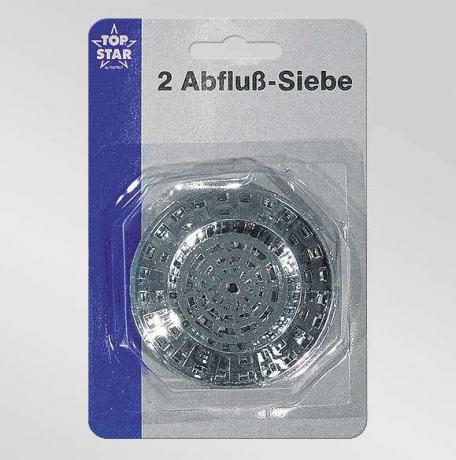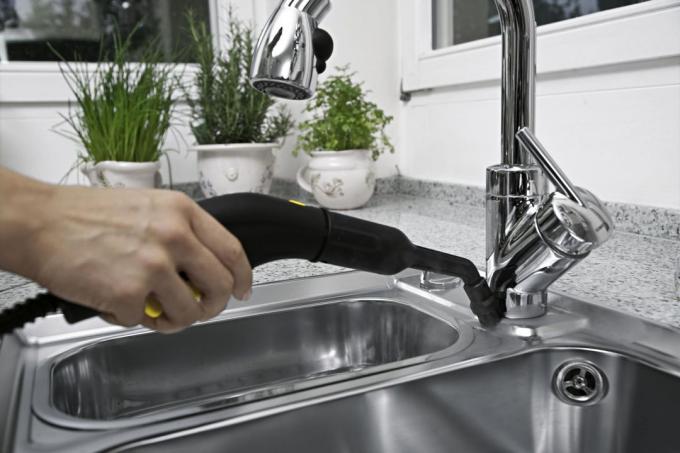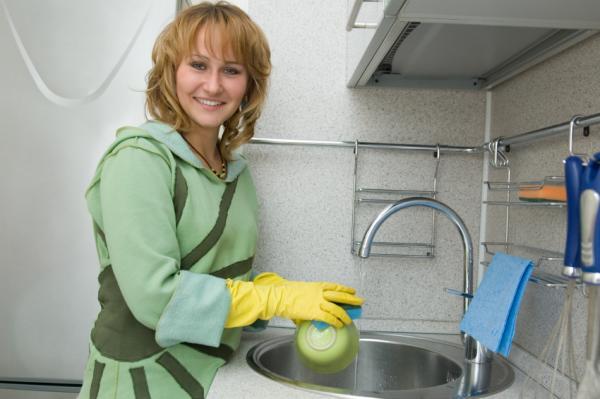Content
-
1 Methods and devices
- 1.1 Ventuz
- 1.2 Soda and vinegar
- 1.3 Cleaning the siphon and pipe
- 2 Precautions
- 3 Conclusion
A clogged sink is a common occurrence in kitchen sinks. To be able to cope with these kinds of problems, there are a few helpful tips to remember. If you know how and how to clean the kitchen sink, you won't be afraid of any blockages.

Sink cleaning is a skill that any housewife will need.
Methods and devices
Ventuz
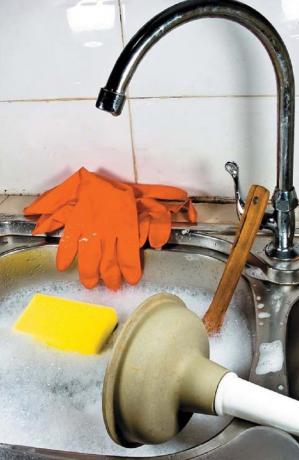
Cleaning with a plunger is the easiest and fastest way.
The first thing to do if the kitchen sink is clogged is to clean it with a plunger. The plunger is a wooden handle with a rubber dome at the end.
Here's how to use this engineering marvel:
- We open hot water;
- We are waiting for a little water to fill up - up to 5 - 7 cm deep;
- We cover the drain hole with a rubber dome;
- We carry out vigorous up and down movements, pumping water through the pipe;
- We remove the plunger and see: if the water freely goes into the drain, then we have coped with the problem;
- If the water does not leave, we repeat the above steps again until the blockage goes away;
- If the blockage does not go away after 5 - 6 attempts, you should resort to other cleaning methods.
Advice! This simple universal tool must be in every apartment, because its price is cheap, and the benefits are enormous. This is probably the most effective way to clean sinks, bathtubs and toilets.
Soda and vinegar
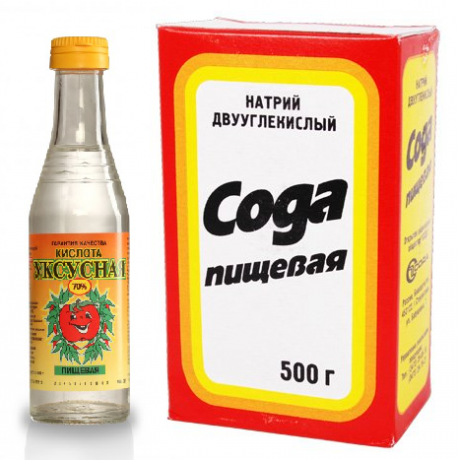
Simple food chemistry can help in the most unexpected situation.
Another simple and uncomplicated way using improvised means. If the plunger doesn't help you, get out regular baking soda and vinegar. You will also need a kettle of boiling water and a thin stick.
Then follow the instructions:
- Wipe the sink dry with a cloth;
- Sprinkle in half a glass (100 ml) baking soda;
- Pour in half a glass of vinegar;
- Pour the baking soda into the drain hole. If it falls asleep poorly, push it with a stick;
- Pour vinegar into the drain hole;
- Boil a kettle of water;
- Pour boiling water into the drain hole.
Important! Before this procedure, check what your siphon is made of. A siphon is a cistern under the sink. If it's made of thin-walled plastic, the boiling water can ruin it. In this case, just pour hot (70 ° C) water.
After you have completed all the items on the list, try cleaning the sink with a plunger. Perhaps she will break through without him, but it's better to play it safe.
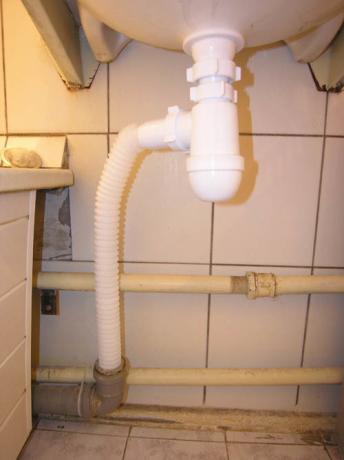
This is what the siphon looks like, which is located under the sink.
Read also the article on stainless steel kitchen sink.
Cleaning the siphon and pipe

Types of plumbing siphons.
Since we have already talked about the siphon, you should immediately talk about this plumbing unit. It is designed to cut off sewer gases and vapors so that an unpleasant smell does not penetrate into your kitchen.
Also in this node a variety of small and not only debris settles. Therefore, the siphons periodically become clogged, especially under the kitchen sink, in which dishes and food are washed.
If the plunger and soda and vinegar did not help, then the blockage is too strong. It is most likely located in the siphon, or under it. In any case, the siphon will have to be disassembled.
This does not require any special skills or talents, it is quite possible to do it yourself.
So, we perform the following sequence of actions:
- Use a wrench to unscrew the cover of the standard model siphon cleaning hatch (not bottle);
- If you have a bottle siphon (this is the one that has a side outlet and a large bottle-shaped bowl at the bottom), then unscrew the sump with our hands;
- If the design of the siphon does not imply access to the inside, unscrew the upper and lower fasteners and remove the entire siphon;
- We are waiting for the water from the siphon to pour into the bucket;
- We wash the siphon with detergent, remove the sediment or plug from it;
- We clean the pipe section above the siphon with a steel wire;
- We check the section of the pipe under the siphon: pour water into it and see if it leaves or not;
- If the water goes well, put the siphon in place and tighten the fasteners;
- If the water does not go into the lower pipe (which comes after the siphon), then it should be cleaned;
- The pipe can be cleaned with a metal cable or steel wire: at the end of the wire we bend the hook, and insert it with the other end into the pipe, rotating as we go, do the same with the cable;
- When the cable or wire comes into contact with the plug, we try to push it, while rotating the cable or wire;
- Gradually, the cork will be pressed through, and water will begin to go into the pipe;
- If the cork does not give in, you will have to apply chemistry.
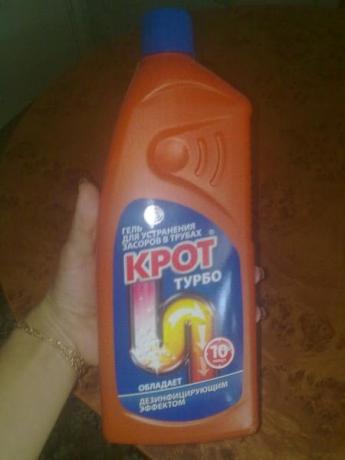
A mixture of active alkalis "Mole" will help fight blockages.
- Pour or pour in the agent (an example is shown in the photo, any agent will do) to clean the pipes into the down pipe and wait according to the instructions;
- Repeat wire or rope cleaning.
Important! If you have a pipe cleaner and time, you do not have to disassemble the siphon, but pour the product directly into the sink drain, pour boiling water on top (or it is better to do according to the manufacturer's recommendations) and after the allotted time, just clean the pipe plunger.
Read also the article "Sink made of artificial stone for the kitchen - style and reliability".
Precautions
- You should also remember to prevent blockages. If you wash dishes, food or herbs, be sure to use a mesh on the drain, and a fine one. Remember to regularly knock this mesh into the trash can (not the sink!). It is also important to regularly wash and wipe down the sink.

Correct mesh for the drain hole.
- Do not use the kitchen sink to wash foreign objects: shoes, clothing, hands, feet, etc. Do not bathe animals in it and do not wash your hair, as hair or wool most often causes the strongest blockages.
- Do not sweep bread and other crumbs into the sink; remove large leftovers from the plates before washing. Once you get used to following these simple recommendations, you will rarely encounter the problem of a clogged sink.
Conclusion
Clearing a blockage in the kitchen sink is a simple and feasible task for a woman, not to mention a man. Do not call a plumber at the first stagnation in the sink.
If the instructions given are not enough for you, watch the video that will help you to more clearly represent all the necessary steps.
Read here the article "Kitchen Sink Smell - Major Causes".
